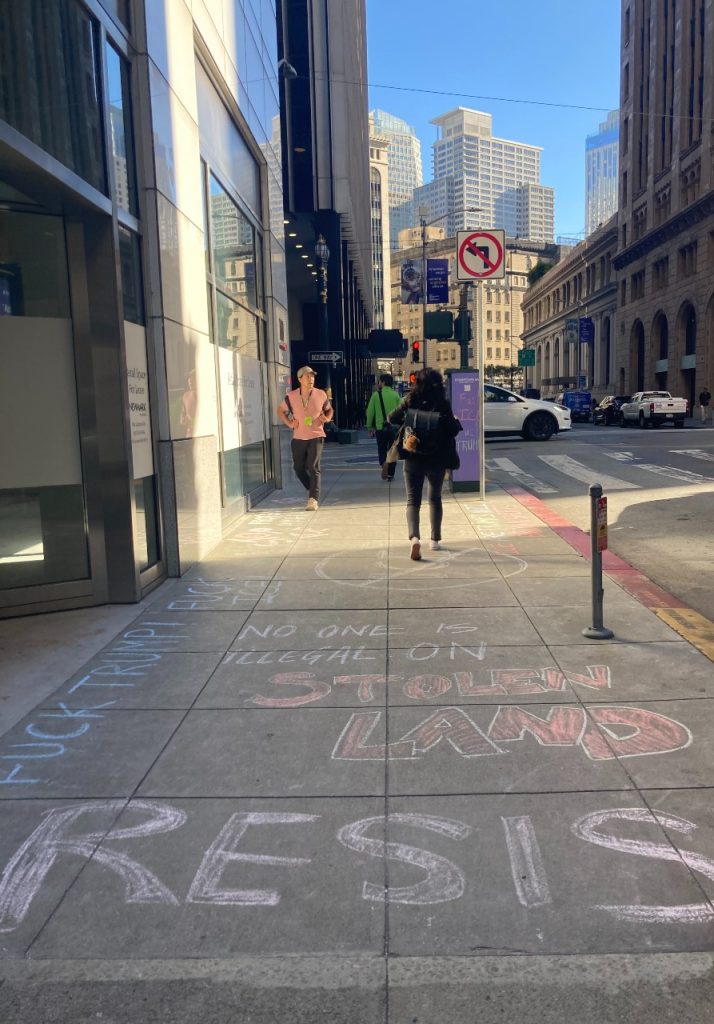
SAN FRANCISCO — A few hours before office workers would flood the streets of San Francisco during the post-work rush, a smattering of kaffiyeh and goggle-clad protesters dotted a quiet block of Sansome Street on Oct.7.
Some clustered around its corners, sitting on the sidewalk as they unwrapped packaged burritos. Others milled around the central-most building, which holds the city’s immigration court.
“It’s usually hours and hours of doing nothing until something happens,” said one of the protesters, a professional musician who lives close to the city.
They stand guard, eight and a half hours, three days a week, hoping to prevent ICE officials from arresting and detaining immigrants coming out of routine court hearings, a practice activists say is unlawful and inhumane but has become increasingly common during President Trump’s second term.
In Northern and Central California, more than 100 immigrants have been arrested and detained at court hearings and supervision check-ins, according to the ACLU of Northern California.
“Immigrants that come here are so nervous and afraid about what might happen to them at the immigration courts,” said Mission resident and protester Ernesto Reyes. “The fact that we can be here—talk to them, provide a protective presence, provide joy—is so powerful because people start to feel more safe.”
For as long as immigration attorney Jordan Weiner has been in her line of work, which is over ten years, people could go to court without fearing ICE arrests.
Most of those arrested, she explained, entered the country without a visa, soon after turning themselves in to immigration officials to ask for asylum. The government then released them into the U.S. so they could wait for a resolution on their cases while attending immigration court hearings.
“Court locations, according to ICE, were sensitive locations and they didn’t want to scare people out of going,” said Weiner, interim executive director of the Mission-based nonprofit, La Raza Centro Legal. “They were very careful about not doing enforcement actions there.”
But that all changed in May 2025.
“Immigration officials started masking up. Armed, big guys would go to court and wait outside of courtrooms for the purpose of arresting people who attended their hearings,” said Weiner.
The immigrants they continue to arrest, explained Weiner, had just had their cases dismissed by a judge.
In many cases, a dismissal can be positive; it allows immigrants to apply for asylum through the U.S. Citizenship and Immigration Services agency, a process that is less adversarial and doesn’t involve immigration court, said Weiner.
On the other hand, immigrants who have been in the U.S. for less than two years become vulnerable for expedited removal, in which they can be deported without the right to appeal.
“The government, without holding a bond hearing, is not even alleging that they are a flight risk or a danger, it’s just arbitrarily snatching them up, secret police style,” Weiner said.
On an average Tuesday, Wednesday or Friday, protesters monitor the San Francisco immigration court at 100 Montgomery Street. Occasionally, when they hear reports of ICE activity at the court’s other location, 630 Sansome Street, they will wait there.
Attendees say no one group is responsible for organizing the protests; instead, people find out through word of mouth and social media. They come for as long as they can, on whatever days they can.
Their day starts at 8 a.m., when the court opens, with chants. Sometimes, guests come play live music, share poetry and do clown routines.
On days with no such guests, The Dragon King, a protester and drag king, will lip-synch to a mixture of English and Spanish songs.
On Tuesday, he stands in stark contrast to the protesters’ black color palette, his jacket bright blue and trimmed with pink fringe, and his face covered in pink and blue makeup.
“I am just one piece of joyful protective presence,” said The Dragon King, who goes by his stage name.
Reyes, alongside, much of the group, feels like they are already starting to see the impact of their protests. That Tuesday, it had been 13 weeks since ICE arrested any immigrants at 100 Montgomery Street.
“Just by being here we’re about to deter them from showing up at all,” said Reyes.
Weiner guesses that the protesters’ consistent presence at 100 Montgomery might be funneling people into only getting arrested at 630 Sansome, which makes things easier for her.
While she doesn’t have enough contacts ready to update her about arrests at 100 Montgomery, she can have people on staff monitor 630 Sansome, which has a significantly smaller number of judges, she explained.
In turn, they can inform her as soon as arrests happen and she can quickly file petitions for immigrants’ release from detainment, which, as of early October, she has done successfully for all 28 of her clients.

